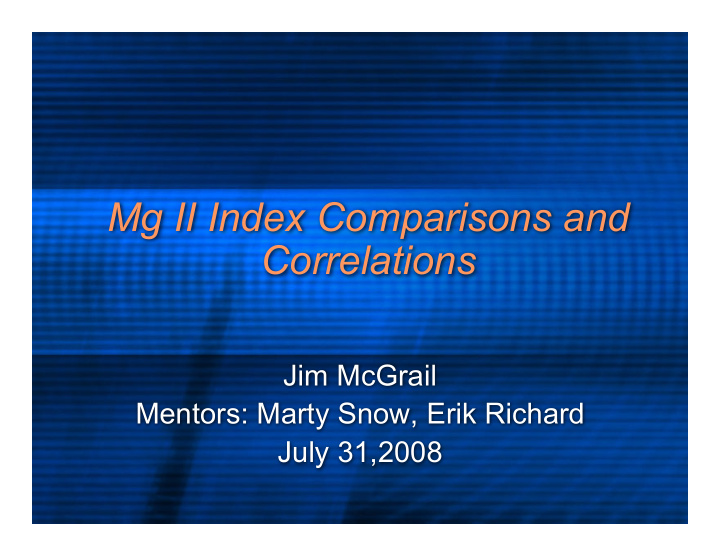



Mg II Index Comparisons and Correlations Jim McGrail Mentors: Marty Snow, Erik Richard July 31,2008
What is the Mg II Index? • It is a measure of the amplitude of the chromospheric Mg II ion (Mg + ) emission • Is highly correlated to EUV/ FUV variability • Measured around 280nm - UV part of spectrum • Ratio of irradiances rather than absolute irradiance
Solar atmosphere
NOAA daily Index since 1978 Official NOAA data
Why is solar variability important? UV light is absorbed in the upper atmosphere, primarily by ozone Mg II can’t be measured from the ground Wavelength < 310 nm get absorbed This controls the amount of ozone O 3 + hv O 2 + O * (excited state) Ozone is an important factor in the Earth’s climate
W hy solar variability is important
Why is the Mg II index important? It is one of the main inputs into models of the ionosphere Important for: satellite drag, GPS, etc. Straight forward to measure (from space) Mg emissions around 280 nm change a lot (~20%) Wings change very little (~0.5%) Measured as a ratio
Why is the Mg II index important? • Easy to measure
Problems with the index There is no continuous measurement Multiple satellites/ instruments SIM, GOME, SCIAMACHY, UARS SOLSTICE, SORCE SOLSTICE, NOAA SBUV series, SUSIM Measurements are on different scales Data collection rates are different
Problems with the Mg II index
My goals Main goal: create an index from all of the data that can predict solar irradiance Compare the Mg II index to other indices Ex: Ca II index To look at short time scale variations One day One rotation
Creating a new Mg II index First, I needed to get data from different satellites SIM instrument measures irradiance; used ratio to create a Mg II index for it
Creating a new Mg II index Next step, compare the different data sets Look at data over similar time ranges Use linear scaling factors
Comparing different data To get a better understanding of the differences, I smoothed the data with a 81 day average (~3 rotations) Then, took ratio’s of the smoothed data This should make it easier to tell which instruments have similar trends in their data
Comparing different data SBUV2/SIM SCIAMACHY/SIM SORCE SOLSTICE/SIM GOME/SIM Ratio to SIM data
Comparing different data I did these same steps for data from earlier missions Decided that the best data sets would be: UARS SOLSTICE, GOME, and SORCE SOLSTICE Created a new Mg II index using this data
New Mg II Index
Using Mg II index to predict irradiance The next step was to see if the new composite index could predict solar irradiance better than the NOAA index I created two models of irradiance, one for each index, to compare to the SORCE measurement To do this, I scaled the Mg II indices to UARS SOLSTICE irradiance between 1997 and 1999 I now have predicted irradiances from my index and the NOAA one extending to 2008
Predicting irradiance To average out the short term variations in irradiance, I took a year long averages from 3/1/03 thru 3/31/04 and 6/1/07 thru 6/30/08 This helps distinguish the long term trend from solar max. to solar min. from any short term trend I then took the ratio of the max/min to represent the spectrum I did this for all wavelengths from 119.5 to 185.5 nm
Making irradiance proxies max 1997- min 1999
Making irradiance proxies 1. Take year long average near solar max. and solar min. for each wavelength 2. Divide the average at max. by the average at min. for each wavelength 3. Do this for NOAA and McGrail proxies and for observed SORCE values
Predicting irradiance SORCE - McGrail - NOAA -
Predicting irradiance Ex: At 120.5 nm
Ca II index I briefly looked at the Ca II index A ground based measurement Good because there is a long record of measurements Don’t need to go to space to measure it Bad because you have to look through the atmosphere Also measured as a ratio Wings aren’t as far away from the core measurement in the solar atmosphere as in the Mg II index
Ca II index
Summary The Mg II index is highly correlated with EUV and FUV variability This means it can be used to make proxy data Compared to NOAA index, my new composite was better at predicting solar irradiance
Questions?
Recommend
More recommend